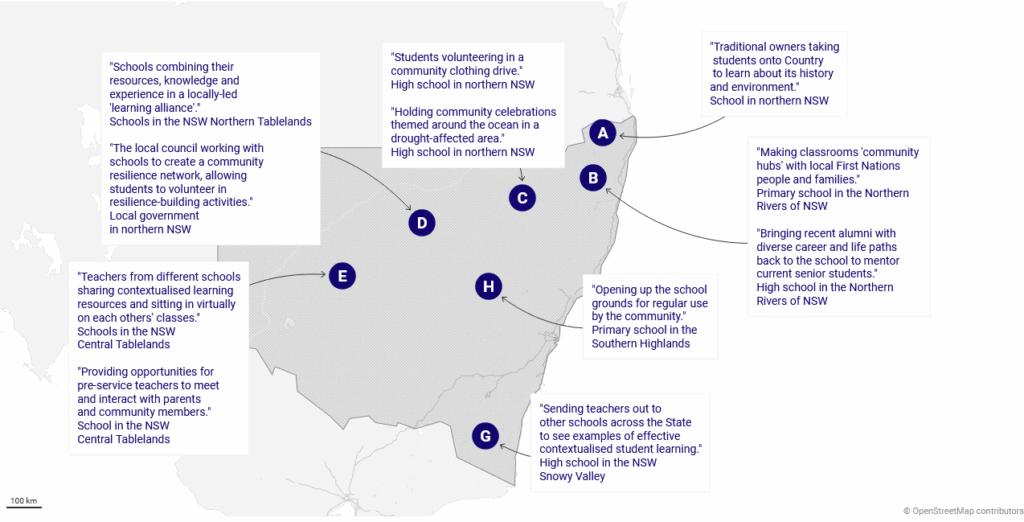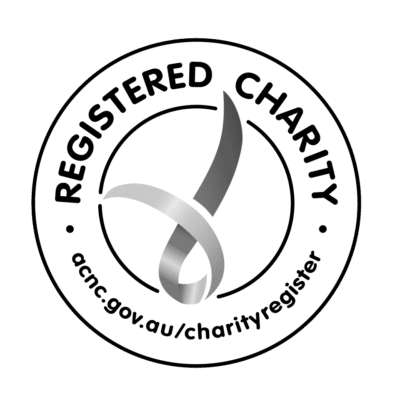Executive Summary
In recent years, schools in regional, rural and remote NSW have been affected by floods, drought, bushfires, animal plagues, and other major disruptions, including COVID-19.
In the face of this, they have overwhelmingly demonstrated strength and adaptability. About two-fifths of NSW schools are in regional, rural and remote areas.
It is vital that a school community’s local capabilities are leveraged and boosted, so that they are ready to deal with future disruptions.
This is what we call resilience: the ability to draw on resources and supports to withstand and manage what school communities are presented with and to develop strength and recovery going forward. Yet resilience is not just about managing disasters. It is about school communities being strong and able to deal with whatever is presented. When a school is resilient, so is the local community–and vice versa. The NSW Department of Education has long recognised the unique needs and contexts of these schools (as distinct from metropolitan ones), reflected in the creation of the Regional, Rural and Remote Education Unit and targeted strategies, such as the Rural and Remote Education Strategy (2021-2024).
This report focuses on two ways to boost the resilience of regional, rural and remote school communities:
- improving links between schools and their local communities; and
- opportunities for contextualised student learning and professional learning of school staff.
School communities with strong social capital and high levels of contextualised student and staff learning are positioned well to endure and recover from a disruption. At their most effective, schools provide support, safety and continuity in times of disaster and recovery; empower communities to participate and look towards the future with confidence; encourage community health and wellbeing; and facilitate connections between the school and community groups, organisations and leaders. This creates the personal capabilities and social infrastructure to respond to present and future shocks.
This report is not intended as a comprehensive strategy; rather, we hope that the ideas which follow inform discussions about education policy and practice to boost resilience through local links and learning. The analysis and identified opportunities for policy and practice are based on desktop research, consultations and workshops involving more than 50 people, including academic experts, school principals, local councils, public servants, and service providers across NSW, Australia and internationally.
This report identifies opportunities in four policy focus areas to boost school and community resilience through local community links and learning.
1
Student development & learning
2
Leadership capacity of principals & teachers
3
A whole-of-school resilience approach
4
Ties between schools & their communities
We have found that focussing on these policy areas can help school communities to build up and nurture the social, logistical, resource and knowledge supports that are required for them to contend with future disruptions, thereby strengthening their overall resilience.
These policy focus areas are interdependent and mutually-reinforcing. We believe that to shift the dial on the resilience of regional, rural and remote school communities, these areas should be progressed together to foster community ties and leverage learning and skills.
Building on this report, further research and policymaking should aim to develop specific and tailored approaches with respect to First Nations people and communities and culturally and linguistically diverse (CALD) groups, recognising their unique circumstances, interests and needs in building resilience.
Opportunities
Student development & learning
Invest in helping to contextualise learning through community engagement:
- Provide guidance on engaging local communities to support teachers on contextually relevant learning.
- Develop an online repository of learning resources for teachers to draw upon that relate to resilience.
- Develop a best practice guide on technology-enabled learning in times of disaster.
Invest in helping schools boost student agency and sense of belonging:
- Ensure that regional, rural and remote students have local leadership and mentoring opportunities.
- Develop consistency in transitioning student cohorts between school stages (e.g. primary to high school)
Leadership capacity of principals & teachers
Invest in school leadership for resilience through specialised training and professional learning:
- Provide more opportunities for principals and teachers to undertake peer networking to share knowledge.
- Expand formal and informal mentoring and coaching opportunities for principals.
- Ensure that professional learning for school staff is flexible, adaptable to context, and modular.
- Collaborate with emergency services to develop joint professional learning with school staff and connect principals into local emergency management planning.
Showcase effective leadership in boosting resilience in regional, rural and remote schools:
- Develop a “showcase” program highlighting schools that demonstrate effective resilience-building.
- Develop a “roadshow” to run local celebrations, professional learning, and student learning on resilience.
Invest in, and create space for, strategic leadership in the community by principals and school staff:
- Assist school leaders to understand how to draw on administrative support during high-stress periods.
- Establish paid leave for school staff to do recognised local community – and/or resilience – building work.
Whole-of-school resilience approach
Invest in developing a whole-of-school approach to resilience:
- Develop a assessment diagnostic tool for schools to gauge their underlying resilience.
- Celebrate “learning alliances” between schools that enable resource pooling and sharing knowledge
- Disseminate strengths-based language around regional, rural and remote schools.
Ties between schools and their communities
Invest in the capacity of schools to grow meaningful and enduring ties with their community:
- Develop a database collating all programs available to schools that support ties with their communities.
- Develop a fund for schools to host community celebrations and recognise contributions to school resilience.
- Ensure broader community use of school facilities is considered in their design and planning their use.
Advise schools on how to expand their connections with key community stakeholders:
- Provide support to schools to strengthen connections to local First Nations and CALD groups.
- Consider the ways to ease the administrative requirements on schools to allow community use of facilities
- Strengthen the role of “community connectors” in schools.
Resilience in Action
School communities practice resilience every day.
Regional, rural and remote school communities are already leading efforts to boost their own resilience through effective, locally led initiatives. Throughout the research for this report, we encountered many examples of school communities boosting their resilience through community ties and leveraging learning and skills. The map below captures examples of “resilience in action” that we heard from school and community leaders from across NSW.

About This Report
Research Approach
This project employed the Institute’s unique collaborative research and policy project model. This model brings together government, academia, and other experts and stakeholders to work cooperatively on challenging policy issues. The core project team comprised Institute staff, two Department of Education representatives, and a university postdoctoral researcher.
The team worked collaboratively throughout three-month period in mid to late 2022. Together, they established a plan to gather the requisite information to answer the research questions, conducted consultations with more than 50 individuals, analysed the evidence collected, and identified opportunities. Current and former school principals in regional, rural and remote NSW, leading researchers and community practitioners on resilience and education, policymakers, and stakeholder groups were consulted throughout. While the Institute managed the process around the project and took leadership over the report’s final design, its content is a product of genuine collaboration between those involved.
Utilising the Institute’s applied policy research approach, this project’s primary information sources are:
– Desktop research drawing together academic sources, “grey” literature and other public information.
– Consultations with expert advisory group members, principals, researchers and practitioners on education and community resilience, community representatives, and stakeholder groups.
– Workshop event held on 23 June 2022 with key stakeholders and experts on regional, rural and remote education and community resilience.
The scope of this project meant that it was not possible to conduct a comprehensive survey of regional, rural and remote schools in NSW. Nor was it possible to meaningfully consider and engage with every existing program, initiative or other piece of work that might already be occurring in NSW – whether led by government, the community, or others.
The primary audience for this report is policymakers, with the insights and opportunities calibrated to focus on system-level reform and investments. At the same time, this report is also intended to be a useful resource for schools (especially principals), community leaders, researchers, and other stakeholders.
Contributors
Project team
– Institute project director and project manager
– Dr Timothy Heffernan, Postdoctoral Research Fellow, University of New South Wales
– Two representatives of the NSW Department of Education, Regional, Rural and Remote Education Unit
Expert advisory group (EAG)
– Two principals of regional, rural or remote schools in NSW
– Professor Rebekah Grace, Western Sydney University;
– Dr Pam Joseph, University of Sydney; and Professor
– Carol Mutch, University of Auckland
– Two NSW Department of Education representatives and one Resilience NSW representative
Consultations
– Nine units across the NSW Department of Education and Department of Regional NSW with responsibility for, or a policy focus on, regional, rural and remote schools or communities
– Twelve leading academic researchers
– More than ten current or former principals of regional, rural or remote schools
Nine community or interest group representatives and resilience practitioners
Explanatory statement on authorship
APPI is a nonpartisan, independent research organisation that does not adopt an institutional view on specific policy issues. The findings and opportunities identified in this report reflect the calibrated, collective view of the project team, which operated under a highly collaborative model.
Its view was formed on the basis of an evaluation of relevant academic research, stakeholder consultations, and engagement with relevant experts, including the expert advisory group (EAG). It does not necessarily reflect the views of the individuals or organisations involved, or of APPI, its Board, funders, or other partners.
This report is licensed under a Creative Commons Attribution-NonCommercial-ShareAlike 4.0 International License.


